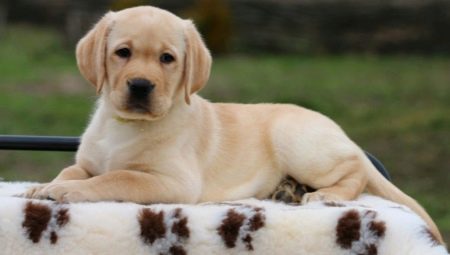Labrador is primarily a hunting dog, but this is not limited to its official capabilities. An animal can become a bloodhound, a guide, a lifeguard. In addition, this is a wonderful, funny friend who gets along well with both adults and children. Such valuable qualities and beautiful appearance made the breed popular and in demand. But before you get a puppy, you should learn how to properly care for him and what includes his education.

What puppies look like
Labrador puppies outwardly resemble plush, well-fed teddy bears. Kids are curious, cheerful and active, a little clumsy and funny.
If the dog’s health is OK, then:
- the puppy is interested in toys, other animals;
- his movements lack stiffness; she moves easily and freely;
- the baby is courageous, sociable, does not get scared and does not hide if hands are extended to him.
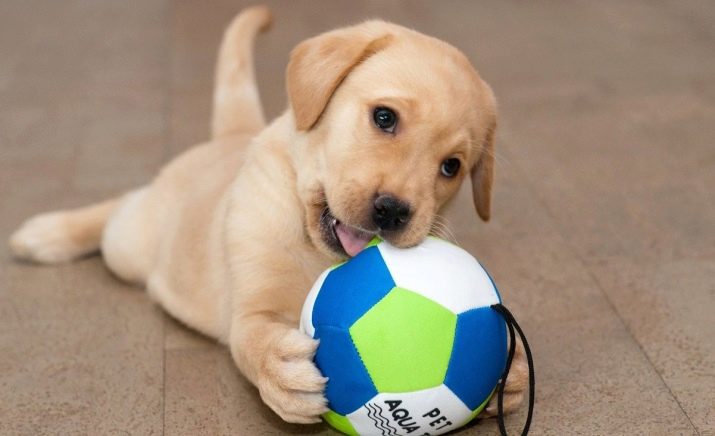
If the puppy is a boy, he is almost always a little larger and weighs more than a girl. Puppy sizes at 2 months:
- height at the withers - 30-32 cm;
- head diameter - 29-32 cm;
- weight - 7-8 kg;
- chest circumference - 30-32 cm;
- muzzle circumference - 20-22 cm;
- muzzle length - 4.5-5.5 cm.
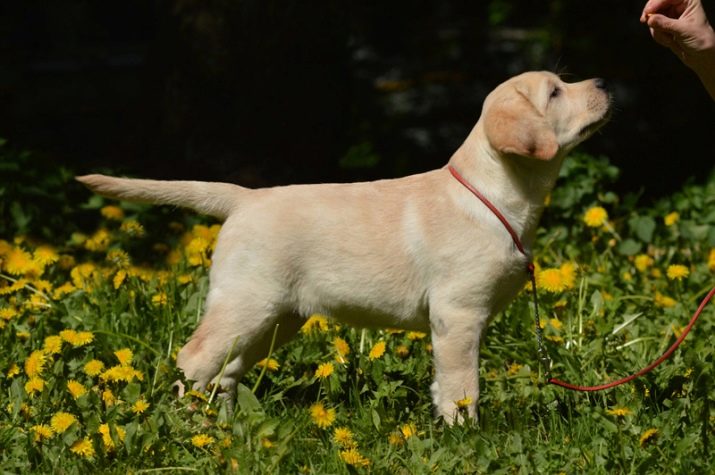
In accordance with the standards, the color of a thoroughbred puppy can be:
- black, including eyelids, nose and lips;
- brown (chocolate) color.
- special features of fawn labradors - with light coat (white, sand, yellow, red), the eyelids, nose and lips have black pigmentation.
However, one cannot accurately predict what the puppy's color will be based on the color of the coat of the parents, and this always remains a mystery and a likely surprise for the breeder.
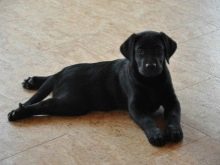


Dog character
What is good about the breed is that the Labrador is a dog suitable even for those who are not particularly versed in dog breeding. This is a smart, obedient and affectionate animal, lively and direct, while his intuition is extremely developed, so the pet can understand a person without words.

Of course, the behavior of a thoroughbred dog, in the first place, is affected by upbringing, but also by the complete understanding by the pet of its purpose. Idleness and lack of movement may not have the best effect on the character of the Labrador. But by nature, this is a friendly, courteous and funny dog, getting along well with adults and children.
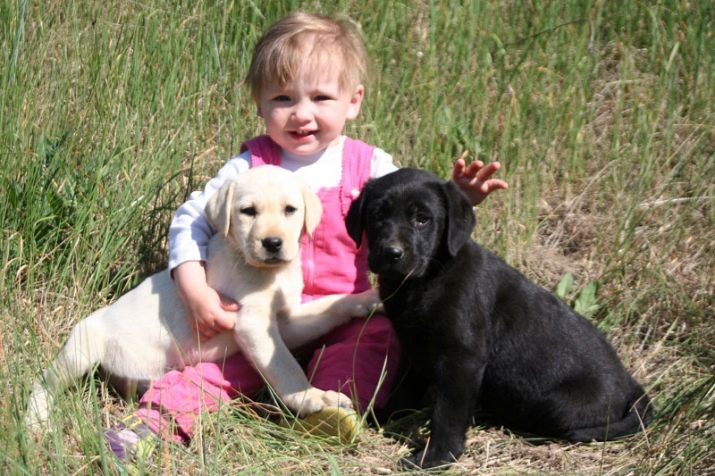
Care and maintenance rules
Raise and accustom the dog to order and hygiene procedures begin immediately. She must have her place. A bedding, which is an elastic mattress covered with a warm bike or fur, can serve as a bed. Puppies sleep peacefully in a place where they are warm and comfortable, so you can give them a corner of the room where there are no drafts.
The dog may whimper the first days, but you cannot take it to bed.

Labrador care consists of the following procedures.
- The animal is taught that the toilet is on the street. The first time is taken out for 5-10 minutes, walks follow immediately after eating. Over time, you will have to walk for 2 hours, providing the dog with maximum physical activity.
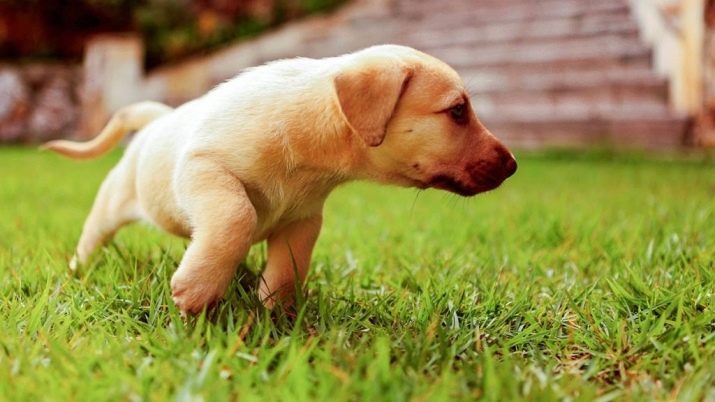
- Puppy must be inspected daily - ears are cleaned once every 2 weeks, once every 7 days they wipe their eyes with a veterinary tonic.
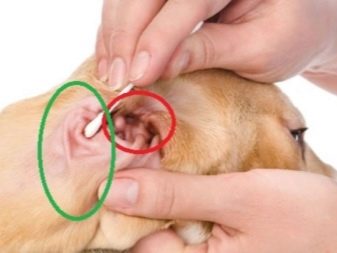

- To clean the teeth using special bones - so the pet enjoys and simultaneously eliminates plaque.
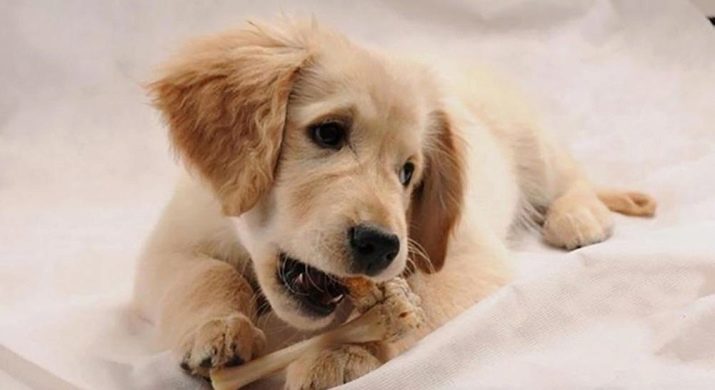
- Claws are cut as they grow up to 2 times a month. In the future, if the dog lives in urban conditions, she herself grinds them on the asphalt. Some Labradors gnaw their claws on their own, if they prevent them from walking, then the owner’s job is to sharpen uneven edges.

- After walking accustom to washing paws. When the puppy grows up, he may well jump into the bath and expose his paws under the stream of included water.
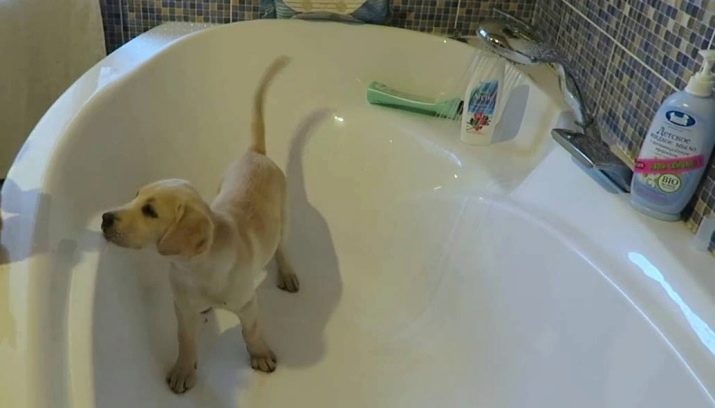
You need to wash the dog with shampoo 3 times a year, but bathe without detergent - much more often.
The puppy can be immersed in a bathtub filled with water for a third, and allowed to splash in warm water, making sure that the liquid does not get into the ears, eyes and nose of the animal. Then the baby is wiped and allowed to dry in warmth, gently combed out. This procedure is beneficial for the health of the skin and coat of the cub.
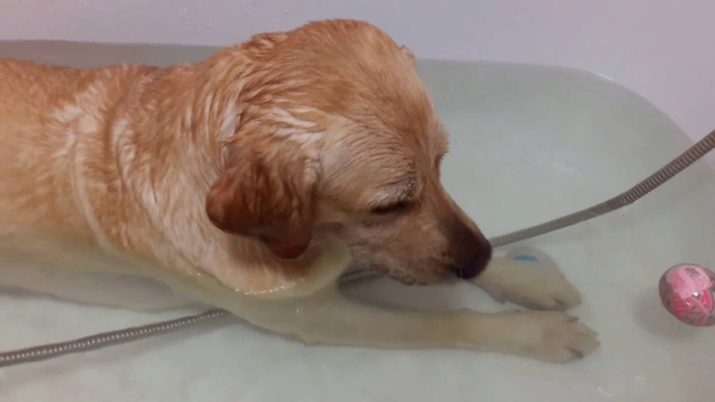
Can I feed homemade food?
The appearance and state of health, including in the future, depend on the proper nutrition of a two-month-old Labrador. With a balanced diet, the puppy is vigorous, active, in a good mood, his coat is shiny, and the weight builds up gradually.
Do not be scared if the baby does not seem too well-fed - this is better than extra pounds that impede the normal formation of joints and tendons of the limbs.

A small puppy can be fed homemade food. This is preferable since natural products containing natural nutrients will initially strengthen the immune system and stimulate the full development of internal organs.
True, you need to prepare for the fact that this method of feeding is much more expensive, you need time to cook, and the baby’s teeth will have to be cleaned regularly.
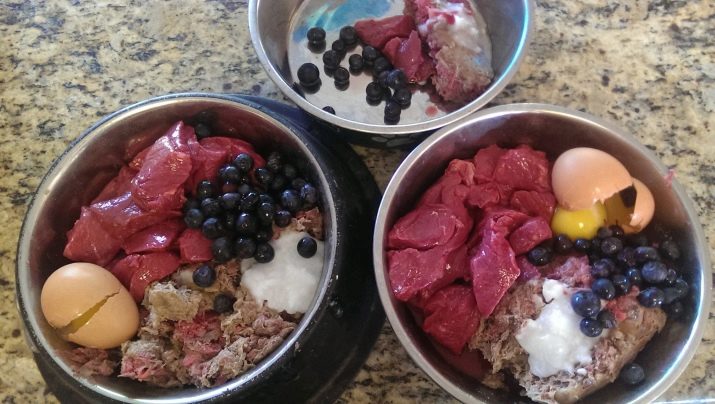
The animal must not be allowed to overeat, for this there is an established norm of feeding.
A dog should eat 2 months a day:
- 15 g of meat per kg of mass;
- 5 g of carbohydrates per kg of body weight;
- 2 g of fat per 2 kg of weight.
Also, the puppy should always have fresh clean water in the public domain, you need to change the bowl regularly.
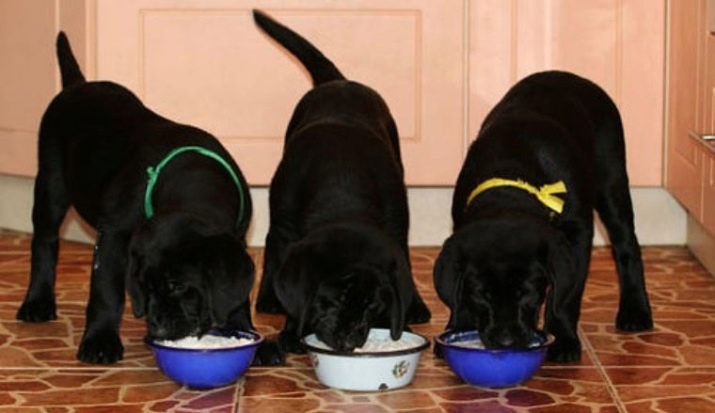
Products that a dog needs:
- raw beef, chicken;
- raw sea fish;
- boiled chicken eggs;
- cereals on meat broth - rice, oatmeal, buckwheat;
- vegetables - fresh, quickly boiled;
- greens and fruits;
- milk;
- dairy products - yogurt, fermented baked milk, kefir, yogurt, cottage cheese.

For a variety of diets, types of cereals, meat and vegetables can be alternated every day, but cereals are invariably cooked in beef or chicken broth.
Raw meat slices are also mixed in porridge.
Early in the morning, you can give the baby cottage cheese with sour cream, oatmeal, flavored with a small amount of honey. At 10 o’clock in the morning the dog should firmly eat porridge with vegetables and meat slices. At lunchtime, the animal is given milk, cottage cheese or any sour-milk drink. Boiled eggs are fed once a week. At 10 o’clock in the evening they offer the pet meat or fish (only raw). In total, a 2-month-old Labrador puppy is fed 5 times a day.
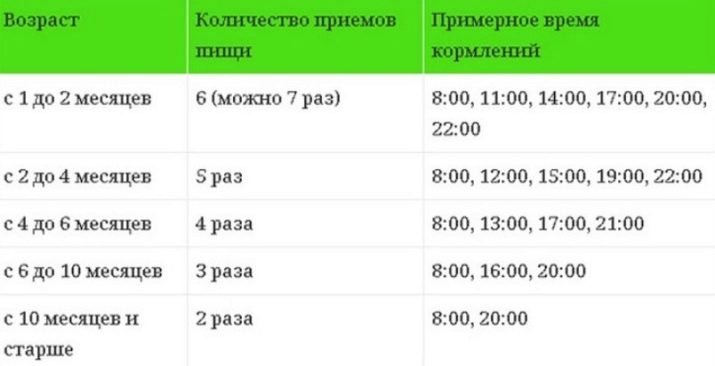
Products that should not be on the animal's menu:
- sweets, including chocolate;
- sausages and sausage;
- potatoes, onions and garlic;
- grapes;
- pork;
- chicken, boiled and tubular bones.
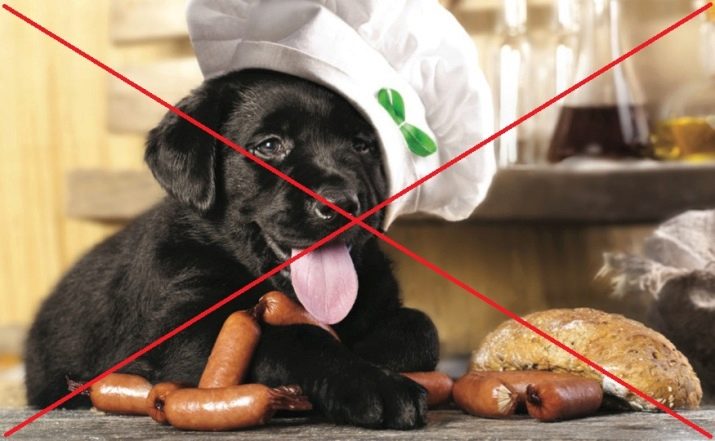
It is necessary to make sure that the pet is not allergic to honey and buckwheat porridge - dogs love buckwheat, but often suffer from intolerance to this cereal. Also note: if the baby licks the plate - it means that he is still hungry.
In the future, the labrador needs clearly dosed portions of food, since the animal is known for its gluttony, a predisposition to overeating, which in the end often leads to excess weight.
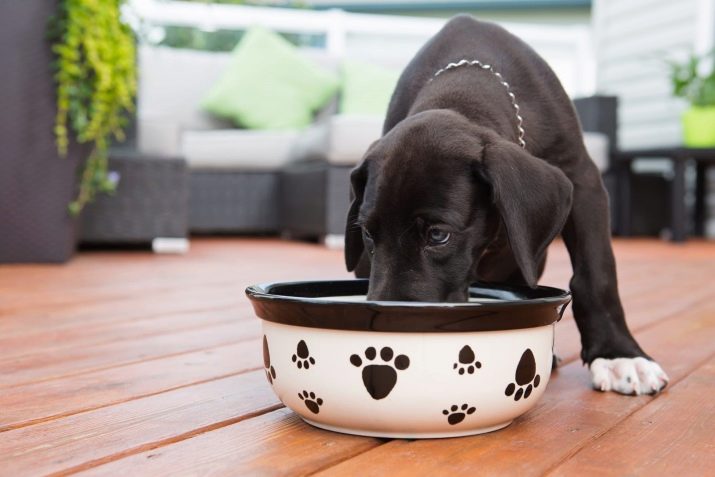
Finished feed
The advantage of industrial nutrition is the absence of the need for cooking, the presence of the necessary additives in the feed, lower costs. However, buying food from unknown manufacturers can lead to the fact that it contains unwanted components. For Labradors, only premium quality dry feeds are suitable. Preferred Elite Brands - Royal Canin, Hills, Purina Dog Chow, Monde Dog.
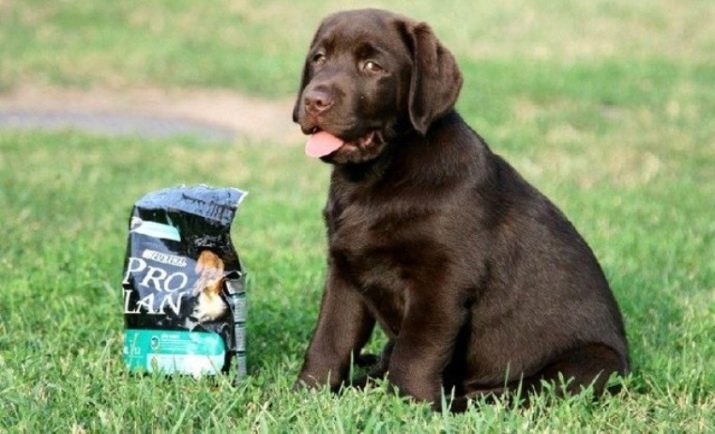
If the owner decided to choose a mixed type of food, then he should know that the puppy should be gradually accustomed to the use of dry food as the main one, first soaking the granules in water. Once a day, the baby receives pieces of lean raw meat.
On this issue, the recommendation of a veterinarian after examining the animal will be required.

Training and education
At 2 months, puppies are subject to all sorts of fears, they may be afraid of even familiar things that have already become them. At this stage, it is better to avoid any situations that cause them stress and negative feelings, including punishment. You can train with a dog by training on a leash and learning simple commands.
Two-month-old Labradors are afraid of loud noises, and it is better to walk with them in less crowded places, for example, in the forest park zone, however, if not all vaccinations are done, walk with caution.

The main teams trained by the animal from 2 to 3 months are “To me”, “Lie”, “Sit”, “Near”, “Fu”, “Place”, “It is impossible”. A day you can devote this lesson to no more than an hour, dividing into 2 or 3 lessons, because the puppy gets tired quickly, and it makes no sense to force him to do something. Every correct action is encouraged by a treat, stroking, kind words.
If, while playing, the little labrador bites and does not listen to the command "Fu" and "Not", you can moderately strong press it to the floor at the withers.
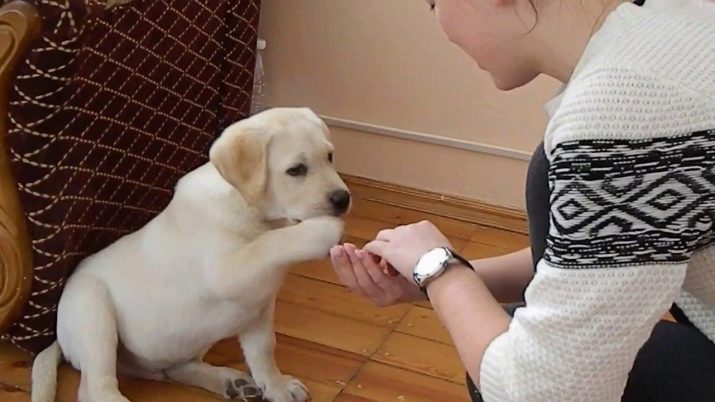
The two-month-old baby already understands a lot, he is studying his new home, the habits of the owner, the behavior of family members and other animals. And the attitude of the dog towards people will depend on how the owner sets himself. This is the time to establish contact with the pet, to find common interests - upon successful acquaintance, the dog will become a loyal friend of the person, his companion and assistant.
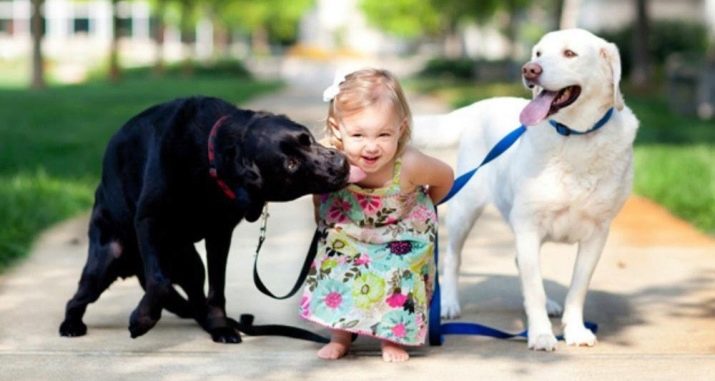
Labrador puppy care tips can be found in the next video.
